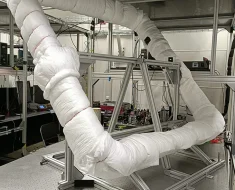
The neutrino “fog” is beginning to materialize.
Lightweight subatomic particles called neutrinos have begun elbowing their way into the data of experiments not designed to spot them. Two experiments, built to detect particles of dark matter, have caught initial glimpses of neutrinos born in the sun, physicists report.
“That’s a triumph,” says neutrino physicist Kate Scholberg of Duke University, who was not involved with the research. The hints of these neutrinos are a long-awaited sign of the detectors’ improving performance. “It’s actually a milestone,” Scholberg says.
Known as the “neutrino fog,” the signature suggests a new way of studying the difficult-to-detect subatomic particles. But it also points toward the beginning of the end for dark matter detectors of this type, which aim to spot the unidentified massive particles that bulk up the cosmos. As these detectors become more capable, the neutrino fog could obscure potential signs of dark matter.
The XENONnT (pronounced “xenon n-ton”) experiment, at the Gran Sasso National Laboratory in Italy, saw signs of neutrinos that had been produced in the sun, physicists reported July 10 at the International Workshop on the Identification of Dark Matter in L’Aquila, Italy. And the PandaX-4T experiment, at the China Jinping Underground Laboratory in Liangshan, saw similar evidence, researchers reported at the workshop July 8 and in a paper submitted July 15 to arXiv.org.
The result “opens [a] new door of using our detectors to study neutrinos and searching for associated new physics phenomena,” says physicist Ning Zhou of Shanghai Jiao Tong University, a PandaX deputy spokesperson.
In the nuclear fusion processes that power the sun, multitudes of neutrinos are produced in a variety of different reactions (SN: 9/1/14). Some of the most energetic come from the radioactive decay of boron-8, a type of boron created during the fusion process. Scientists had long predicted that those neutrinos are prevalent enough, and have the appropriate energies, to be seen in dark matter detectors. That’s what the two dark matter detectors have found.
Each experiment houses several metric tons of liquid xenon. If a dark matter particle crashes into the nucleus of a xenon atom, the experiments can detect that nucleus recoiling in response, revealing dark matter’s presence. But neutrinos can also slam into atomic nuclei, causing similar recoils.
This type of interaction, in which a neutrino knocks into an entire atomic nucleus rather than an individual proton or neutron, was first seen in 2017 in the COHERENT experiment, using neutrinos from a laboratory source (SN: 8/3/17). The two new experiments mark the first signs of nucleus-thwacking by neutrinos from the sun. Scientists previously detected solar neutrinos by other means (SN: 6/24/20).
In the future, detecting solar neutrinos via the nuclei they knock around could help physicists understand the particles better. For example, scientists could study the neutrino signal to look for what detectors might be missing: hypothetical “sterile” neutrinos that wouldn’t interact with matter at all, aside from gravitational forces (SN: 10/27/21). Dark matter detectors might also spot neutrinos from other sources, such as nearby exploding stars.
“It’s very cool to see that we can turn this detector into a neutrino observatory,” says physicist Michael Murra of Columbia University, a member of the XENONnT collaboration.
Neutrinos aren’t yet limiting the performance of dark matter detectors. The solar neutrino signal would obscure only low-mass dark matter particles, which fall below the mass range that these detectors scrutinize most carefully for dark matter. There’s still a long way to go before neutrinos start to swamp dark matter detection of higher masses.
The next generation of dark matter detector, beyond XENONnT and PandaX-4T, should still be able to search for dark matter. But further improvement will start to become difficult. Instead, scientists could move to detectors that measure the direction of the incoming particles. That would allow researchers to look for dark interactions originating away from the sun, eliminating solar neutrinos from their data.
#Dark #matter #experiments #peek #neutrino #fog
Image Source : www.sciencenews.org






